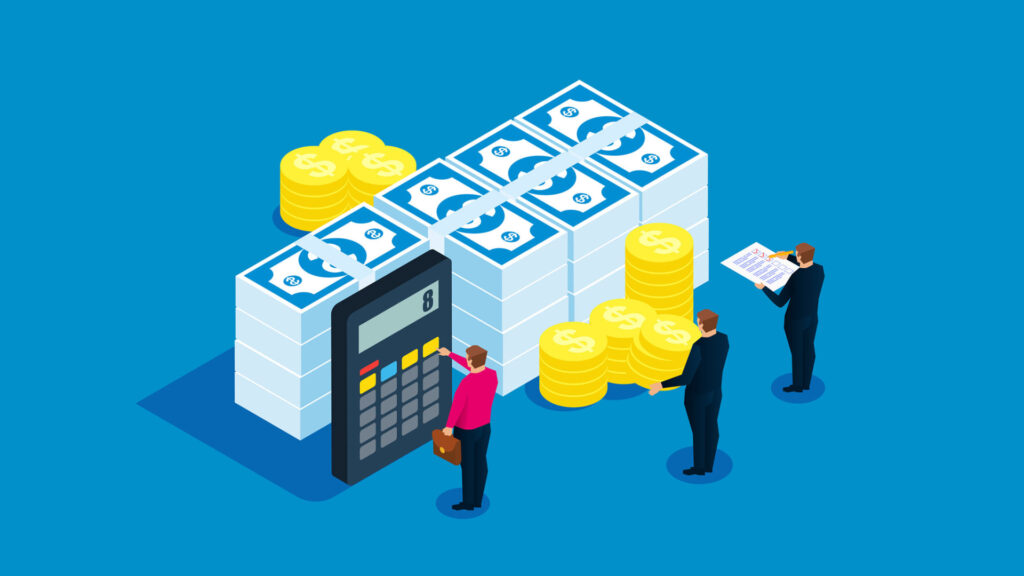How To Value A Business?
Pondering what your blood, sweat and tears might literally be worth can be a pretty fun daydream as a business owner. There are lots of reasons to value a business with the most obvious one being you want to sell up shop – whether that’s for retirement or to move onto the next venture. Valuing businesses is far from straight forward. There are numerous ways to do it and the option usually depends on your industry.
Here are the basics to know about valuing a business.
Key Insights
- Importance of Business Valuation: Valuing a business is crucial for various reasons, including selling, restructuring, succession planning, bringing in new partners, and attracting investors.
- Factors Influencing Valuation: Several factors influence business valuations, such as the impact of external events like COVID-19, individual circumstances, intangible assets like intellectual property (IP), the length of time in business, and tangible assets.
- Valuation Methods: Various methods can be used to value a business, depending on the industry and specific circumstances.
Reasons To Value A Business
- If you’re selling a business, you need to know it’s worth. If you’re buying a business… you need to know what the investment looks like. In this scenario, the seller would have the business valued, with the documents then provided to potential buyers. This is a starting point for negotiations and there’s usually then room for movement either up or down according to who’s interested
- If you’re selling an asset
- If you’re restructuring a business (and the reasons to do this are many)
- Succession planning
- If you’re looking to bring in a new partner to the business, you need a valuation to then determine their buy-in amount
- Attracting investors
- Wanting to know what your hard work is worth!
Factors That Can Influence Business Evaluations
How the process goes is something like this: consider the industry and which valuation method is often used in this context, then understand and apply other factors that will affect that valuation. For example:
- Covid. Unless you’re one of the lucky few, ‘rona really did a number on net profit for many businesses – the marker which many valuations are based on. If this is the case, we’d aim to normalise that profit to show a more accurate picture outside of ‘rone times
- Individual circumstances. For instance, a forced sale or disposal of shares (often because the bank is knocking at your door) will alter the valuation
- Intangible assets like IP. Putting a value on this is the hardest part of valuation
- Time you’ve been in business. If you’ve got a long, strong track record, then your valuation looks the goods. Length often means a proven track record, customer loyalty etc. This is one of the intangible assets that can add value
- Tangible assets like property and equipment
If you approach it theoretically, three critical factors significantly impact business valuation: Financial Statements, Market Conditions, and Business Growth Projections. Financial statements offer a snapshot of a company’s economic health, including details on revenues, expenses, and profit margins, which collectively determine the business’s financial stability and worth. Market conditions, encompassing economic climate and industry benchmarks, play a pivotal role, as favourable or unfavourable market trends can either augment or diminish a company’s valuation. Lastly, business growth projections are essential, as they provide insights into future earnings potential, with optimistic projections often leading to higher valuations. By thoroughly analysing these elements, businesses can attain a more accurate and robust valuation.

The different ways a business can be valued
There’s no one-size-fits-all when it comes to valuing a business. We look for industry rules of thumb first as often, there will be a common practice.
Earnings multiple
The most common, and often the most simple way of valuing a business is to take the net profit (once things like depreciation and interest are added back on) and multiply that number based on the industry. If it’s booming – take caravans for instance – you might multiply by six to eight. If it’s an industry where patients or clients are fleeting (like healthcare) then you’d have a lower multiplier like two to three. As a basic rule of thumb, three point five is the usual multiplier you’d add to most businesses. Then, if it’s an IP based business you add perceived value on top of that (more on this below).
Asset valuation
Exactly what it says: the value of the business lies in its assets and is based off the balance sheet – the net assets once you’ve minused the liabilities. Equipment and machinery hire is a common one for this. If the seller has done accelerated depreciation for tax purposes, this will need to be adjusted to find the true current value of those assets.
IP valuations
The most valuable asset some businesses – think about a creative agency – is their intellectual property. Specialised software providers are another example of this, or certain food businesses with special recipes.
Usually, you’d work off the net profit and then attempt to work out what the future earnings from that IP would be. It’s almost about estimating what that IP can earn you in the future as the buyer. It’s very subjective, and therefore difficult to do. Then, you’d often have an earn out arrangement which means having the payment structured over a period of time and if the sales don’t match what was predicted then the sale price decreases to reflect this.
As mentioned, the starting point is the net profit. Then, we add back certain things like items that aren’t business related (for instance a big salary that the owner is paying themselves) and figure out the actual cost of hiring someone for that role at the market rate. We add back depreciation and interest. Anything owner related – electricity bills through the books, cars – are also added back. Once you’ve got that figure, the multiple is decided on and you’ve got your value.
Price earnings ratio
This one’s a little more complicated. It’s the business dividends divided by profit after tax. For example a company share price is $40 and earnings per share after tax is $8. The price earnings ratio is 5. Then, we’d multiple the business’ most recent profit after tax by 5,and you’re left with the value of the business. So a PER of 5 with after tax profits of $100k would mean the business valuation would be $500k. This applies to larger businesses where their share value is easily determined.
Comparable sales method
If you’ve got a local milkbar and another one in the area has sold for a certain price, then you can simply base it off that.
Capitalised future earning method
This is the most commonly used method to value small businesses. The future earnings are given an expected value. Then we work out the average net profit over the last three years and take into account the owners’ transactions, and make the adjustments. The next step it to work out what the expected ROI is (divide business net profit by cost and turn it into a percentage). For instance, you’re considering a business that’s got an average net profit of $100k after adjustments. The owner wants a ROI of 20%. Divide $100k by 20% and multiple by 100 to get a value of $500k.
More specific industry examples…
There are industry rules of thumb for specific businesses. For example, gyms who operate on subscription models. The buyer wouldn’t necessarily be too concerned about the financials of the business, they’d care more about how many people the gym has under contract on the subscription and what that’s worth.
Similarly, an IT provider that has a certain amount of clients gains interest through that rather than how they’re actually running the business. It’s the same for accounting firms who are essentially selling the value of your books or fees.
Another example would be a chiro who might sell based on a year’s worth of fees.
When it comes to real estate agencies, the buyer might be purchasing three locations and would be more interested in understanding the market share of those areas rather than paying attention to their net profit only.
Buyers work out what’s important to them in valuing a business and the seller would then base the valuation on that.
Importantly, all valuations must be brought back to external factors. The method is selected, applied and then the other factors (as listed above) are considered.
As you can see, this is no simple task. We value businesses regularly – get in touch if it’s something you’re interested in!
Step-by-Step Preparing for Business Valuation

Preparing for a business valuation involves several critical steps to ensure an accurate and comprehensive assessment of your small business’s worth. This preparation is vital for presenting a clear picture to investors, buyers, or stakeholders. Here’s a step-by-step guide to help you get ready for the process:
Step 1: Assemble Essential Financial Documents
- Income Statements: Gather detailed records of your revenue and expenses to provide a clear view of your profitability.
- Balance Sheets: These give a snapshot of your business’s financial condition, including assets, liabilities, and equity.
- Cash Flow Statements: Show the inflows and outflows of cash in your business to indicate liquidity and operational efficiency.
- Tax Returns: Ensure your recent tax returns are organised and accessible for financial verification.
Step 2: Evaluate Tangible and Intangible Assets
- Property and Equipment: List and evaluate all physical assets owned by the business.
- Intellectual Property: Assess the value of patents, trademarks, copyrights, and any other proprietary technology or processes.
- Customer Lists and Contracts: Document key relationships and ongoing contracts that add to business value.
Step 3: Analyse Market Conditions and Industry Trends
- Economic Climate Assessment: Understand current market conditions and how they affect your industry.
- Competitive Analysis: Evaluate your position relative to competitors and identify industry benchmarks.
- Market Demand: Assess current demand trends for your products or services.
Step 4: Project Future Earnings and Business Growth
- Revenue Projections: Create future earning forecasts based on historical data, market trends, and business plans.
- Growth Rate Assumptions: Establish realistic growth rates for future projections.
- Risk Analysis: Identify potential risks and develop mitigation strategies to reassure investors.
Step 5: Conduct a Self-Assessment
- Business Strengths and Weaknesses: Perform a SWOT analysis to identify strengths, weaknesses, opportunities, and threats.
- Management Team Evaluation: Assess the experience and capabilities of your management team as it affects business performance.
Step 6: Prepare a Comprehensive Valuation Report
Executive Summary: Write a clear and concise summary of your business and the purpose of the valuation.
Detailed Financial Analysis: Include all relevant financial documents, earnings projections, and asset valuations.
Valuation Conclusion: Present a well-supported conclusion regarding your business’s value, including valuation methods and assumptions used.
Step 7: Consult with Valuation Experts
Professional Appraisers: Engage with certified business valuation professionals for an objective and expert valuation.
Industry Specialists: Consult specialists who understand the nuances of your specific industry for a more accurate valuation.
Leveraging Professional Business Valuation Services
Engaging professional services can enhance the accuracy and credibility of your business valuation. Consider hiring a trusted accountant in Melbourne with expertise in small business valuations to help you prepare financial statements and professional financial advisors that can provide tailored advice and thorough assessments.
Utilising Xero accountants can streamline the process with advanced accounting software, ensuring precise financial data integration and analysis. Additionally, a small business bookkeeping service maintains organised financial records, essential for a comprehensive valuation.
By leveraging these experts, you can achieve a meticulous and reliable business valuation, supporting informed decision-making and strategic planning.
FAQ
What Documentation is Needed for a Business Valuation?
Essential documentation includes income statements, balance sheets, cash flow statements, and tax returns. Accurate and up-to-date financial records are crucial for a thorough valuation process.
What is the Discounted Cash Flow (DCF) Method?
The Discounted Cash Flow (DCF) method estimates a business’s value by projecting its future cash flows and discounting them back to their present value using a discount rate. This insider technique considers the time value of money, ensuring an accurate valuation based on expected future performance.
What is the Comparable Market Analysis Method?
The Comparable Market Analysis (CMA) method values a business by comparing it to similar companies that have recently been sold or are publicly traded. This comparison method uses metrics like revenue, profit margins, and market multiples to estimate a business’s worth relative to its peers.
What are Common Business Valuation Methods?
Common business valuation methods include:
1. Discounted Cash Flow (DCF) Method: Projects future cash flows and discounts them to present value, considering the time value of money.
2. Comparable Market Analysis: Compares the business to similar companies recently sold or publicly traded, using metrics like revenue and profit margins.
3. Asset-Based Valuation: Values the business based on the total value of its assets minus liabilities.
4. Earnings Multiple Method: Uses a multiple of the business’s earnings (e.g., EBITDA) to estimate its value.
5. Book Value Method: Based on the value of a business’s net assets as recorded on the balance sheet.
How Can Small Business Bookkeeping Services Aid in Valuation?Small business bookkeeping services maintain meticulous records, ensuring all financial statements are accurate and up-to-date. This organisation is vital for a credible and comprehensive valuation.













